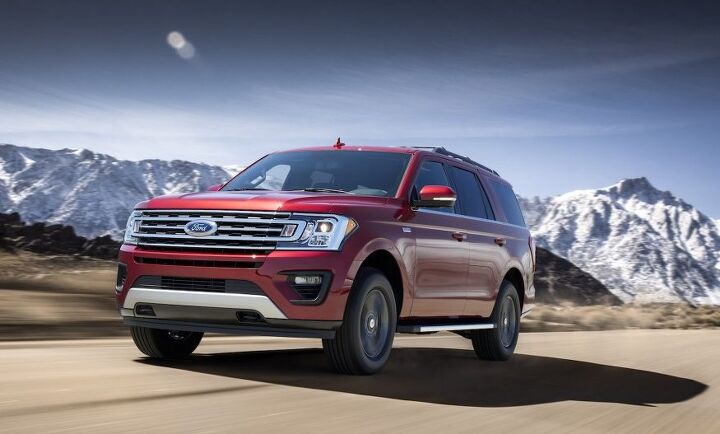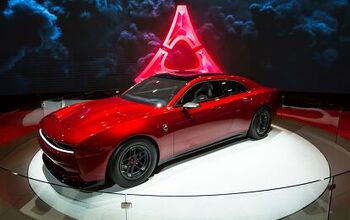The New Thriftpower? EPA Says Less-thirsty 2018 Ford Expedition Tops Its Class

There’s nothing quite as uncertain as that little number staring at you from the window sticker of a new vehicle. It’s two digits long (unless you’re fabulously rich), followed by the word “combined.” We’re talking, of course, about the Environmental Protection Agency’s fuel economy rating, which often turns out to be an impossible-to-reach goal or — if you’re lucky — a lowballed figure.
Back in the days of lapels and flares, the hot gas mileage action was found in the compact and subcompact class. Economy cars, after all. Well, people these days prefer driving a vehicle that seats at least five adults in comfort while towing a boat and hauling 65 pounds of kid’s toys and a dog in the rear cargo area. With the heyday of the cheap little car long gone, the (fuel) economy battle rages anew among the largest, and most lucrative, vehicles on the road.
So, do you believe the EPA when it says the massive 2018 Ford Expedition gets 20 miles per gallon combined?
That’s the official rating for the regular length, rear-drive Expedition, which is wholly new for the 2018 model year. Adding wheelbase or four-wheel traction brings that figure down by 1 mpg in either case, or 2 mpg with both factors combined. Still, the entry-level Expedition’s fuel economy tops its main rival’s rating by 1 mpg, and that’s no small thing for Dearborn brass.
This rating makes it a class-leader.
With Ford, topping the 2018 Chevrolet Suburban’s base price by nearly $1,500 is no big deal if enough buyers come over to the Expedition camp — and if they’re willing to shell out nearly $80,000 for a top-flight variant, all the better. However, fuel economy is a marketing win.
The EPA rates the 2WD 2018 Suburban at 16 mpg city, 23 mpg highway, and 19 mpg combined — 1 mpg below the Suburban in each category. Add 4WD, and the Suburban still sits below the Expedition, though choosing the 4WD Expedition MAX brings the two combined ratings to par.
This shouldn’t surprise, as the two rivals sport very different powertrains. In the Suburban, you’ll find a very familiar 5.3-liter V8 and six-speed automatic. (So, familiar, we’re told it’s actually quite comforting. In the Ford, there’s an upgraded version of the 3.5-liter EcoBoost V6 sporting an extra 10 horsepower and 50 lb-ft of torque, hitched to a 10-speed automatic. That brings the model up to 375 hp and 470 lb-ft.
In contrast, the Suburban’s mill generates only 355 hp and 383 lb-ft.
While it looks like Ford has its cake and is able to eat it, too, there’s a reason the saying “your mileage will vary” exists. We haven’t had a chance to spend a week in the new Expedition yet, but past reviews have made us suspicious of the lofty fuel economy ratings of certain body-on-frame Ford vehicles. Two F-150 pickups, in both 5.0-liter/six-speed and 3.5EB/10-speed guise, fell short of the advertised combined rating after a week of fairly forgiving driving.
In his recent test of the 2017 Suburban, Mark “Bark M” Baruth’s mileage was just 0.5 mpg shy of the combined EPA rating. Because of this, we’re taking the EPA rating with a grain of salt.
But who knows, Ford might surprise us all. Certainly, the new Expedition’s aluminum-heavy weight loss regimen points to an automaker that’s concerned about thirstiness. The 2018 model should start rolling off dealer lots later this year.
[Image: Ford Motor Company]

More by Steph Willems
Latest Car Reviews
Read moreLatest Product Reviews
Read moreRecent Comments
- Honda1 Unions were needed back in the early days, not needed know. There are plenty of rules and regulations and government agencies that keep companies in line. It's just a money grad and nothing more. Fain is a punk!
- 1995 SC If the necessary number of employees vote to unionize then yes, they should be unionized. That's how it works.
- Sobhuza Trooper That Dave Thomas fella sounds like the kind of twit who is oh-so-quick to tell us how easy and fun the bus is for any and all of your personal transportation needs. The time to get to and from the bus stop is never a concern. The time waiting for the bus is never a concern. The time waiting for a connection (if there is one) is never a concern. The weather is never a concern. Whatever you might be carrying or intend to purchase is never a concern. Nope, Boo Cars! Yeah Buses! Buses rule!Needless to say, these twits don't actual take the damn bus.
- MaintenanceCosts Nobody here seems to acknowledge that there are multiple use cases for cars.Some people spend all their time driving all over the country and need every mile and minute of time savings. ICE cars are better for them right now.Some people only drive locally and fly when they travel. For them, there's probably a range number that works, and they don't really need more. For the uses for which we use our EV, that would be around 150 miles. The other thing about a low range requirement is it can make 120V charging viable. If you don't drive more than an average of about 40 miles/day, you can probably get enough electrons through a wall outlet. We spent over two years charging our Bolt only through 120V, while our house was getting rebuilt, and never had an issue.Those are extremes. There are all sorts of use cases in between, which probably represent the majority of drivers. For some users, what's needed is more range. But I think for most users, what's needed is better charging. Retrofit apartment garages like Tim's with 240V outlets at every spot. Install more L3 chargers in supermarket parking lots and alongside gas stations. Make chargers that work like Tesla Superchargers as ubiquitous as gas stations, and EV charging will not be an issue for most users.
- MaintenanceCosts I don't have an opinion on whether any one plant unionizing is the right answer, but the employees sure need to have the right to organize. Unions or the credible threat of unionization are the only thing, history has proven, that can keep employers honest. Without it, we've seen over and over, the employers have complete power over the workers and feel free to exploit the workers however they see fit. (And don't tell me "oh, the workers can just leave" - in an oligopolistic industry, working conditions quickly converge, and there's not another employer right around the corner.)































Comments
Join the conversation
We know egoboost engines drink fuel in the real world. This will be lucky to see any better than 17.
I think of EPA stickers as a guide for comparison only. Achieving the results is not going to happen. Too many factors affect gas mileage to come up with a number that will match your driving style and conditions